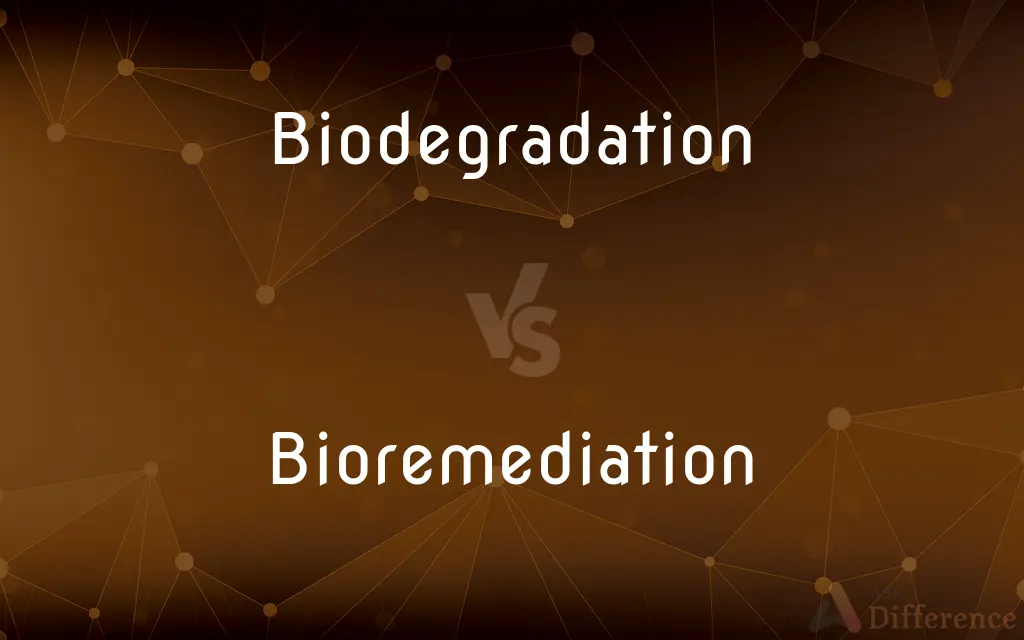Biodegradation vs. Bioremediation — What's the Difference?
By Tayyaba Rehman & Fiza Rafique — Updated on May 2, 2024
Biodegradation involves the natural breakdown of substances by organisms, whereas bioremediation is the deliberate use of biodegradation to clean up contaminated environments.

Difference Between Biodegradation and Bioremediation
Table of Contents
ADVERTISEMENT
Key Differences
Biodegradation is a natural process where organic substances are broken down by living organisms, typically microorganisms, into simpler compounds. Whereas bioremediation leverages this natural biodegradation process to manage and remediate environmental contaminants, often employing specific microorganisms to target particular pollutants.
In biodegradation, the process can occur under a variety of environmental conditions and does not necessarily require human intervention. On the other hand, bioremediation is an engineered solution that often involves the optimization of environmental conditions to enhance the efficiency of contaminant breakdown.
Biodegradation can lead to the complete mineralization of organic substances into water, carbon dioxide, and basic elements. Whereas bioremediation focuses on transforming hazardous contaminants into non-toxic or less toxic forms, which is particularly crucial in areas affected by industrial pollution.
The efficiency of biodegradation can vary significantly based on factors such as temperature, pH, and the presence of oxygen or other electron acceptors. In contrast, bioremediation often involves careful monitoring and control of these factors to maximize the degradation of pollutants.
Biodegradation is an essential part of the natural recycling of organic materials in ecosystems. While bioremediation is a practical application that helps mitigate environmental hazards, promoting ecosystem health and reducing the impact of human activities on the environment.
ADVERTISEMENT
The outcomes of biodegradation are beneficial for maintaining the natural cycle of matter and energy in the environment. Meanwhile, bioremediation provides an effective method for cleaning up oil spills, heavy metals, pesticides, and other hazardous substances from contaminated sites.
Comparison Chart
Definition
Natural breakdown of substances by organisms.
Use of biodegradation to clean up environmental pollutants.
Dependency on human intervention
Occurs naturally without human intervention.
Often requires human intervention for optimization.
Primary function
Recycling of organic material in ecosystems.
Remediation of contaminated environments.
Control of conditions
Conditions not controlled; occurs naturally.
Conditions often controlled and optimized.
Focus
General breakdown of organic compounds.
Targeted breakdown of specific pollutants.
Compare with Definitions
Biodegradation
The natural decomposition of organic material by microorganisms.
Paper and food waste undergo biodegradation in compost piles.
Bioremediation
The engineered use of biological processes to treat contaminated sites.
Bioremediation techniques are commonly used to clean up oil spills.
Biodegradation
A biological process essential for the recycling of materials in ecosystems.
Biodegradation of dead matter prevents the accumulation of waste in the environment.
Bioremediation
Often requires monitoring and manipulation of environmental parameters.
Bioremediation projects may adjust soil pH to enhance microbial activity.
Biodegradation
The process by which complex substances are broken down into simpler ones through biological means.
The biodegradation of leaves in a forest contributes to nutrient cycling.
Bioremediation
Implemented in both in situ and ex situ forms depending on the contamination site.
In situ bioremediation involves treating the contaminated material at the site.
Biodegradation
Intrinsic to natural ecosystems and does not require human facilitation.
The biodegradation of animal feces occurs naturally in wild habitats.
Bioremediation
Aims to transform hazardous substances into non-toxic forms.
Bioremediation has been used to reduce toxicity in industrial wastewater.
Biodegradation
Can be slow or fast depending on environmental conditions.
Biodegradation of plastic is much slower than that of organic food waste.
Bioremediation
Involves the strategic use of microorganisms to degrade environmental pollutants.
Specific bacteria are introduced into soils to promote the bioremediation of heavy metals.
Biodegradation
Biodegradation is the breakdown of organic matter by microorganisms, such as bacteria and fungi.
Bioremediation
Bioremediation is a process used to treat contaminated media, including water, soil and subsurface material, by altering environmental conditions to stimulate growth of microorganisms and degrade the target pollutants. Cases where bioremediation is commonly seen is oil spills, soils contaminated with acidic mining drainage, underground pipe leaks, and crime scene cleanups.
Biodegradation
Capable of being decomposed by biological agents, especially bacteria
A biodegradable detergent.
Bioremediation
The use of biological agents, such as bacteria or plants, to remove or neutralize contaminants, as in polluted soil or water.
Biodegradation
The decomposition of any material by microorganisms.
Bioremediation
(biochemistry) The use of biological organisms, usually microorganisms, to remove contaminants, especially from polluted water
Bioremediation
The branch of biotechnology that uses biological processes to overcome environmental problems.
Bioremediation
The branch of biotechnology that uses biological process to overcome environmental problems
Bioremediation
The act of treating waste or pollutants by the use of microorganisms (as bacteria) that can break down the undesirable substances
Common Curiosities
Can biodegradation occur without any human intervention?
Yes, biodegradation occurs naturally in the environment without the need for human intervention.
What is biodegradation?
The natural breakdown of organic materials by microorganisms into simpler substances.
How does bioremediation differ from biodegradation?
Bioremediation is a targeted use of biodegradation to clean specific pollutants under optimized conditions.
In what environments can biodegradation take place?
Biodegradation can occur in various environments including soil, water, and air, as long as microorganisms are present and the conditions support microbial activity.
How is bioremediation implemented?
Bioremediation can be implemented in situ (at the site of contamination) or ex situ (where contaminated materials are removed and treated elsewhere), depending on the extent and nature of the contamination.
Why is bioremediation important?
Bioremediation is crucial for managing environmental pollution, as it offers a natural, cost-effective, and sustainable method to detoxify contaminated sites, reducing the impact of pollutants on ecosystems and human health.
What types of contaminants can be addressed through bioremediation?
Bioremediation can address a wide range of contaminants, including petroleum hydrocarbons, heavy metals, pesticides, and organic solvents.
What is bioremediation?
The use of biological processes, particularly biodegradation, to remove or neutralize environmental pollutants.
What role do microorganisms play in bioremediation?
Microorganisms such as bacteria and fungi are the primary agents in bioremediation, breaking down pollutants into less harmful substances through metabolic processes.
Is bioremediation always effective?
The effectiveness of bioremediation depends on various factors including the type of contaminant, the presence of suitable microorganisms, and environmental conditions. It may not be suitable for all types of pollutants.
Can biodegradation contribute to pollution?
While biodegradation generally reduces pollution by breaking down harmful substances, in some cases, intermediate breakdown products can be more toxic than the original substances.
Share Your Discovery

Previous Comparison
Brute vs. Man
Next Comparison
Botanic vs. BotanicalAuthor Spotlight
Written by
Tayyaba RehmanTayyaba Rehman is a distinguished writer, currently serving as a primary contributor to askdifference.com. As a researcher in semantics and etymology, Tayyaba's passion for the complexity of languages and their distinctions has found a perfect home on the platform. Tayyaba delves into the intricacies of language, distinguishing between commonly confused words and phrases, thereby providing clarity for readers worldwide.
Co-written by
Fiza RafiqueFiza Rafique is a skilled content writer at AskDifference.com, where she meticulously refines and enhances written pieces. Drawing from her vast editorial expertise, Fiza ensures clarity, accuracy, and precision in every article. Passionate about language, she continually seeks to elevate the quality of content for readers worldwide.













































